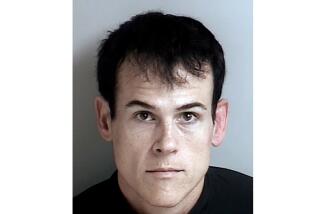
To investigators at the scene of Polly Klaas’ abduction in early October 1993, the story strained belief. A thick-bearded stranger had entered the 12-year-old girl’s room while she was hosting a Friday night sleepover. He had a knife. He told the three girls he would slit their throats if they screamed.
He tied their hands using ligatures and electrical cord cut from a Nintendo game box in the room. He pulled pillowcases over the heads of Polly’s friends and ordered them to count to a thousand. Her mother was asleep, just down the hall in their home in Petaluma, Calif.
In this series, Christopher Goffard revisits old crimes in Los Angeles and beyond, from the famous to the forgotten, the consequential to the obscure, diving into archives and the memories of those who were there.
“A stranger abduction,” an FBI supervisor called it immediately. But some investigators had doubts. Such abductions are rare, and this specific scenario — a child taken from her bedroom, by a stranger, in front of witnesses — defied their collective experience.
Day after day, as the story became national news and pressure mounted on detectives, they grilled the 12-year-olds who had seen it happen. Was this some kind of prank? Did Polly have a boyfriend? Had she run off with him? Were they covering for her?
Detectives fixated on tiny discrepancies. One girl said the intruder had worn a yellow headband; the other didn’t remember it. One had heard a slamming door; the other did not. One passed a polygraph; the other showed inconclusive results.

“This is bull[—]. It never happened,” one Petaluma police detective told another, as quoted in the book “In Light of All Darkness: Inside the Polly Klaas Kidnapping and the Search for America’s Child” by Kim Cross.
“The interviewers were told to lean on them almost like you would a suspect,” Cross (a friend of this reporter) told The Times in a recent interview. “And they were threatened, ‘You know Polly’s parents are suffering. You could make this stop if you just tell us the truth. If you’re lying, you could go to juvenile hall.’ And the girls’ stories never changed.”
Eddie Freyer was the senior agent in the FBI office in nearby Santa Rosa when he was called to the scene. He worked closely with the Petaluma Police Department.
Thousands of leads poured in, but at first “we had absolutely nothing,” Freyer told The Times. He said investigators hoped to elicit information by asking the girls questions multiple times in different ways. Their motives were “honorable but misplaced, pressuring those two girls to the point where they really didn’t want to talk to us anymore,” Freyer said.

An army of volunteers searched the surrounding woods. Thousands of dead-end leads were called in. Psychics arrived to offer their services.
“Everybody was trying to attach themselves to this case because of its ever-growing notoriety,” Freyer said. “People would want to go visit the house and walk through a bedroom and get a reading and all these sorts of things.”
The big break came in late November, when a Sonoma County woman was hiking in the woods near her home about 25 miles from the Klaas home. She found some discarded clothing, including a pair of child-sized tights.
The woman remembered how, on the night of the kidnapping, she had encountered a strange, menacing trespasser whose Pinto was stuck in a ditch.
Hours after Polly’s abduction, two Sonoma County sheriff’s deputies had detained the man, freed his car and let him go. They had not heard the all-points bulletin with a rough description of the kidnapper — dispatchers had not broadcast it for fear of alerting reporters who might be listening to scanners.
“As the investigation unfolds, we do not know about that detention, because the two deputies never called us,” Freyer recalled. “It would have saved us a lot of heartburn and grief. Would it have changed the ultimate outcome of the case? Probably not.”

The trespasser’s name was Richard Allen Davis, 39, a spottily employed sheet metal worker who had been paroled three months earlier on a kidnapping conviction from the state prison in San Luis Obispo.
He had a striking resemblance to the composite sketch the 12-year-old witnesses had helped create.
Scanning Polly’s bedroom, the FBI had used relatively new “alternate light source” technology, which made fingerprints visible under special powders. They had found a latent palm print on her bunk bed. Now, they matched it to Davis.
Police arrested Davis on a parole violation and held him in isolation in the Mendocino County jail. He admitted nothing. A friend who visited revealed what was in the news: Police had Davis’ palm print. Then he started talking.
He said he’d been smoking weed and drinking beer on the night he entered Polly’s house. He admitted to strangling her. He took police to where he had dumped her body in a nearby farm town.

He gave a credulity-straining story about the night of the abduction, however. He said that while the deputies were questioning him at the ditch where his car was stuck, Polly was waiting on a nearby hillside where he had left her, alive.
Freyer doesn’t believe it. Nobody does.
“The assault occurred up there, and he more than likely killed her up there,” said Freyer, now 73 and retired.
Freyer has traveled the world lecturing to law enforcement agencies about the case and its lessons, including the need for quick evidence-collection teams, cooperation and communication between agencies, and specialists trained to interview child witnesses in a nonthreatening setting.
Why did Davis pick that house and that victim? Investigators believed he had been in Polly’s neighborhood before, maybe lingering in the nearby park, and had spotted her walking down the block to buy an ice cream.
Davis’ extensive criminal record, and the leniency he had received over the decades, aroused outrage. As far back as 1977, a probation officer had called him a threat to society who could not function outside prison. He admitted that he heard voices telling him to rob and rape.
Twice, he had escaped from psychiatric wards. Among his convictions: abducting a woman in her car at knifepoint in 1976, for which he served five years, and kidnapping a woman at gunpoint from her home in 1984, for which he served eight.
At the trial for Polly’s murder, Davis’ attorney did not dispute his client was the killer but denied he had sexually assaulted the girl. A jury found Davis guilty of 10 felony counts, including attempting a lewd act on a child.

At the sentencing, Davis directed a vile remark at Marc Klaas, the victim’s father, who lunged at him.
“Mr. Davis, this is always a traumatic and emotional decision for a judge,” Santa Clara County Superior Court Judge Thomas Hastings said, sentencing him to death. “You made it very easy today by your conduct.”
The case — along with the 1992 murder of 18-year-old Kimber Reynolds, shot by a parolee trying to steal her purse — gave impetus to California’s enduringly controversial “three-strikes” law.
The law imposed mandatory sentences of 25 years to life for felons with two prior violent crime convictions, treating even nonviolent felonies, such as residential burglary, as a third strike.
Marc Klaas initially supported the law but came to fear that its impact would “skewtoward young Black dudes” because of harsh punishments for crimes less serious than murder.
At the time, Klaas told the public: “I’ve had my stereo stolen and I’ve had my daughter murdered, and I know the difference.”
In 1994, Gov. Pete Wilson signed three-strikes into law, and California voters approved it, casting ballots for Proposition 184 in overwhelming numbers. Two years later, when the state Supreme Court gave judges discretion to remove strike convictions so they could not be used against defendants at sentencing, Klaas was convinced the guardrails were sufficient. He threw his support behind three-strikes again.
In 2012, Proposition 36 modified the law to require that all three offenses be serious or violent. But it remains a bête noire for critics of mass incarceration. (Los Angeles County Dist. Atty. George Gascon told his prosecutors not to seek sentencing enhancements under the law, spawning a lawsuit now before the California Supreme Court.) Klaas continues to support the law, despite his earlier doubts.

If you have information on old crimes, famous, once-famous or obscure, contact [email protected]
After his daughter’s murder, Klaas launched the KlaasKids Foundation, a victims rights nonprofit with an emphasis on protecting children. He championed bills such as Megan’s Law, which notified the public about registered sex offenders, and coordinated search and rescue operations for missing kids and young adults.
“They said [Polly’s friends] were lying because they knew Polly had run away with her boyfriend,” Klaas said. “We aggressively did everything we could to stop that mind-set.”
He was steadfast in demanding the death penalty for his daughter’s killer. In 2019, Gov. Gavin Newsom invited him to Sacramento for a conversation and then announced a moratorium on executions, saying he had consulted with victims’ advocates. It left Klaas feeling cruelly used.

“We just had a bull— conversation for about 45 minutes,” Klaas told The Times. “The governor of the state called the father of a murder victim and had him drive 200 miles for the express purpose of being able to say, ‘I talked to him.’ I can’t imagine what else it was for, because there was no content to the meeting whatsoever.”
Klaas joined the recall effort against Newsom in 2021, which failed. Newsom dismantled San Quentin’s death row, and Davis was transferred to a less restrictive facility. Klaas doesn’t think he will live to see Davis executed.
“I gave that up years ago,” he said. “So many good people that worked on Polly’s case have died. This guy Richard Allen Davis has been able to live on.”
Klaas, 75, said he will retire at the end of the year and close down his foundation. He could not find a successor.
“There were people I tried to mentor, to move the whole agenda forward, but nothing ever stuck,” he said.
More to Read
Sign up for Essential California
The most important California stories and recommendations in your inbox every morning.
You may occasionally receive promotional content from the Los Angeles Times.













